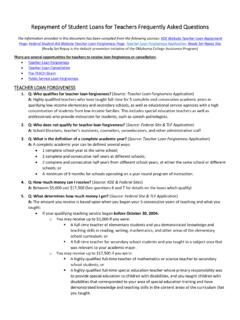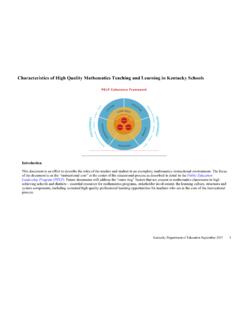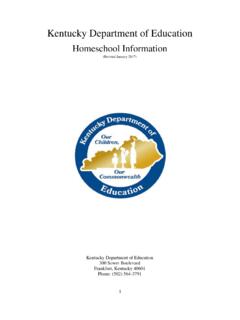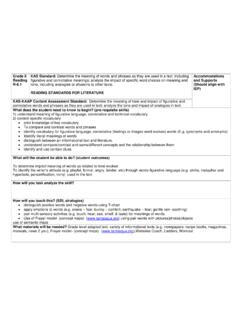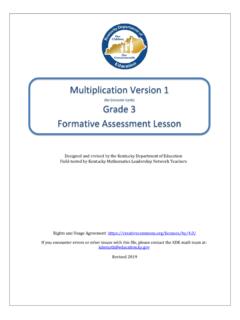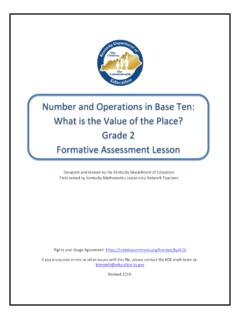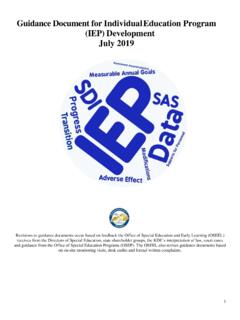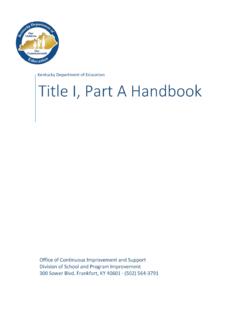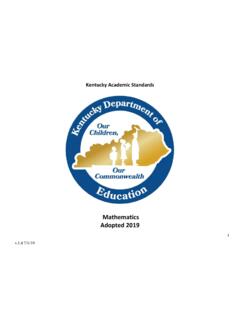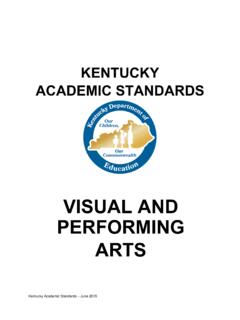Transcription of KENTUCKY PARAEDUCATOR ASSESSMENT
1 KENTUCKY PARAEDUCATOR ASSESSMENT study guide REVISED 2nd EDITION KENTUCKY DEPARTMENT OF EDUCATION October 2009 The KPA study guide was updated for ADA Web Accessibility Compliance May 2018 resulting in minor layout and formatting changes. Content remains the same. KPA study guide REVISED 2nd EDITION 2 (Oct. 2009) ACKNOWLEDGMENTS The Paraeducators of KENTUCKY (PEK) Project at the Human Development Institute, University of KENTUCKY , would like to express its gratitude to the following individuals for their continual support of the PEK Project: Dr. Johnnie Grissom, Associate Commissioner Office of Special Instructional Services KENTUCKY Department of Education Larry Taylor, Director Division of Exceptional Children Services KENTUCKY Department of Education Debbie Hicks, Director Division of Federal Programs & Instructional Equity KENTUCKY Department of Education The KENTUCKY Department of Education (KDE) would like to express its gratitude to the following individuals for their valuable insight, experience, feedback, and dedication that made this guide possible.
2 Amy Humphrey, KENTUCKY Department of Education Ava Taylor, KENTUCKY Department of Education Barbara Locker, Human Development Institute, University of KENTUCKY Candace James, Woodford County Public Schools Charma Linville, KENTUCKY Department of Education Deborah Jackson, Jefferson County Public Schools Deborah Waggoner, Woodford County Public Schools Denise Bailey, KENTUCKY Department of Education Jaynae Laine, KENTUCKY Department of Education Landrea Miriti, Bluegrass Community & Technical College Linda Montgomery, KENTUCKY Department of Education Dr. Mary Persley, Jefferson County Public Schools Mina Hammons, Owen County Public Schools Dr. Pat Lefler, Bluegrass Community & Technical College Robin Hebert, KENTUCKY Department of Education Shelda Hale, KENTUCKY Department of Education Vanessa Hale, Fayette County Public Schools KPA study guide REVISED 2nd EDITION 3 (Oct. 2009) TABLE OF CONTENTS Instructions for KENTUCKY PARAEDUCATOR ASSESSMENT study guide 4 Requirements for Paraeducators in KENTUCKY 5 Literacy 6 Mathematics 16 PARAEDUCATOR Roles and Responsibilities 27 Instructional Strategies 32 Appendix A: Literacy Terminology 46 Appendix B: Mathematical Glossary and Review 50 Appendix C: Acronyms and Glossary 59 Appendix D: English Language Learners 66 Appendix E: Students with Special Needs 70 Appendix F: References, Resources, and Endnotes 74 KPA study guide REVISED 2nd EDITION 4 (Oct.)
3 2009) INSTRUCTIONS FOR KENTUCKY PARAEDUCATOR ASSESSMENT study guide This booklet is designed as a study guide for the KENTUCKY PARAEDUCATOR ASSESSMENT (KPA). It also will provide the applicant or existing PARAEDUCATOR with information about the role of the PARAEDUCATOR and strategies for assisting with student instruction in reading, writing, and mathematics. In addition, the study guide is designed as an initial step in a PARAEDUCATOR s professional development and will provide strategies for working with teachers and students in the instructional setting. Review of the guide will prepare you for taking the KPA. The KPA will cover material contained in the following sections of the KPA study guide : Literacy (Reading and Writing), Mathematics, PARAEDUCATOR Roles and Responsibilities, and Instructional Strategies. Information noted in the appendices also is covered in appropriate sections of the ASSESSMENT . INFORMATION ABOUT THE KENTUCKY PARAEDUCATOR ASSESSMENT Check with the local school district to see where and when the KPA will be administered.
4 Also, check to see if training will be provided using the KPA study guide . You should be prepared for the following when you go to take the KPA. A trained proctor will assist you. 1. You must provide a picture ID for the proctor to verify the identity of the test-taker. 2. The KPA will be administered at the local school district or adult education center. Contact the district or center in your area. For locations of adult education centers, see the KENTUCKY Adult Education Center website. 3. All questions are multiple-choice or true/false. There are three sections of the ASSESSMENT : Literacy, Mathematics, and Instructional Strategies (including PARAEDUCATOR Roles & Responsibilities). 4. There are 20 questions in each section of the ASSESSMENT for a total of 60 questions. You must correctly answer 48 out of 60 questions to pass the KPA. 5. Remember that there may be no undue assistance during the ASSESSMENT no talking, no calculator, no web browsing, no use of a phone, and no use of the study guide .
5 You may have blank paper and pencil/pen for scratch work. 6. The test is not timed. However, the district or center may place consistent guidelines on time to complete the ASSESSMENT . 7. If you do not correctly answer 48 out of 60 questions, then you may retake the entire ASSESSMENT two additional times (for a total of three). There may be reasons for which a district makes an exception and allows the test-taker to take the test more than three times. The reason must be documented at the local level. The district or center may provide additional training if you do not pass the KPA KPA study guide REVISED 2nd EDITION 5 (Oct. 2009) REQUIREMENTS FOR PARAEDUCATORS IN KENTUCKY The Elementary and Secondary Education Act (ESEA) addresses educational qualifying factors for paraeducators. Specifically, all paraeducators working in a program supported with Title I, Part A funds must have a secondary school diploma or its recognized equivalent.
6 New employees must meet the ESEA educational requirement before they are hired to provide instructional support in a program supported with Title I, Part A funds. To provide consistency and ensure that all paraeducators are highly qu alified, districts may choose to develop a policy in which all paraeducators with instructional duties are required to meet the ESEA educational requirement. Paraeducators whose duties include instructional support and who work in a program supported with Title I, Part A funds must meet the ESEA educational requirement through one of the following: 1. completed two years of study at an institution of higher education ( Two years of study means the equivalent of two years of full-time study as defined by the institution. For some institutions that may mean 12 credit hours per semester, requiring a total of 48 credit hours, while in ot hers it may mean 15 credit hours a semester, requiring a total of 60 credit hours.)
7 ; or 2. obtained an associate (or higher) degree; or 3. met a rigorous standard of quality and be able to demonstrate, through a formal state or local academic ASSESSMENT , knowledge of and the ability to assist in the instruction of reading, writing, and mathematics (or as appropriate, reading readiness, writing readiness, and mathematics readiness). Properly trained paraeducators play important roles in schools where they can magnify and reinforce instruction in the classroom. Unfortunately, studies often show that paraeducators are used to assist in teaching although their educational backgrounds may not qualify them for such responsibilities. ESEA includes higher standards to ensure that students who need the most help are assisted by highly qualified paraeducators. The law also requires that high-quality and ongoing professional development is provided for paraeducators working in pr ograms supported by Title I, Part A funds.
8 The training should enable paraeducators to assist children to meet the state s student academic achievement standards. The KENTUCKY Department of Education (KDE) has chosen the KENTUCKY PARAEDUCATOR ASSESSMENT (KPA) as a means of assessing paraeducators who do not meet the higher education requirements stipulated in ESEA. Candidates should check with the local school district in which they might be seeking employment to verify the acceptance of scores from the KPA or if the district is using a KDE- approved alternative ASSESSMENT . A district may, at its discretion, determine that a PARAEDUCATOR meets the ESEA educational requirement if the individual was previously determined to meet the requirement when employ ed by another district. Content found throughout the study guide , including information noted in the appendices, may appear on the KPA. KPA study guide REVISED 2nd EDITION 6 (Oct. 2009) INTRODUCTION TO ASSESSMENT CONTENT Just as it is important to assess a PARAEDUCATOR s abilities to instruct students in the areas of literacy (reading and writing), and mathematics, it is also important to assess his/her knowledge in these key areas of education.
9 The KPA is designed to assess the PARAEDUCATOR candidate s abilities to provide instruction as well as his/her knowledge of reading, writing, and mathematics. LITERACY Before beginning, take a moment to review a term frequently used by educators. Literacy is the ability to read, write, listen, speak, and observe to a competent level in all content areas. Thus, in instruction, all components should be integrated. The skills found in reading and writing are separated in this guide as a way to prepare you for the KPA. READING READING SKILLS KNOWLEDGE As a PARAEDUCATOR , you should be able to understand, analyze and evaluate written messages. The following reading skills may be evaluated in the KPA. 1. Literal Comprehension. Questions focus on the content of the text or passage that is directly stated or implied. Questions may be asked about the main idea of the passage, supporting details or ideas, the organization of the passage or statement, the use of language in the passage or statement, and the meanings of words presented in the passage or statement.
10 2. Critical and Inferential Comprehension. These questions will ask you to go be yond the explicit content to the impl ied meanings or underlying reasons for the statements. You will ne ed to make careful judgments about the quality of the passage content. Questions may focus on strengths or weaknesses of the author s argument, relevance or appropriateness of the evidence the author presented to support the argument, the difference between fact and opinion, inferences that can be drawn from the passage or statement, the attitude of the author toward the subject matter discussed (tone), extensions or analys is of the ideas in the passage, or conclusions that can be drawn from the pa ssage. Guidelines for Preparing for Reading Comprehension and Analytical Reasoning The following guidelines may assist you in preparing for reading comprehension and analytical reasoning questions. The questions contained in this section of the KPA are based solely on the passage provided and do not require a PARAEDUCATOR to have outside knowledge of the material presented.
